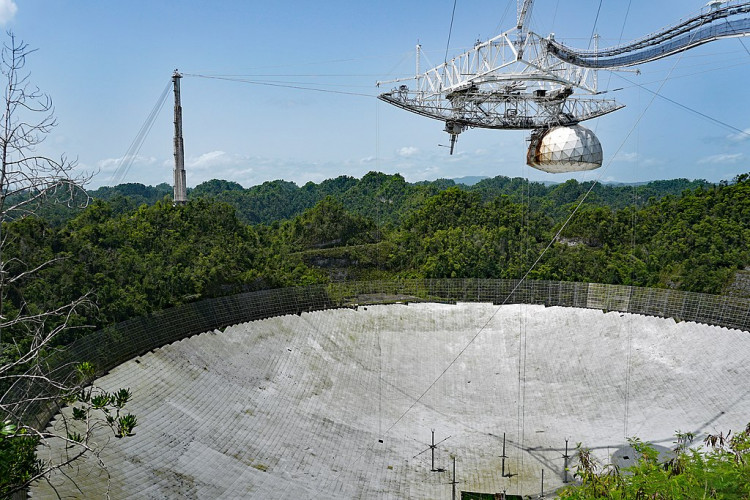The U.S. National Science Foundation has just announced the start of the decommissioning of the famed Arecibo Observatory, a 1,000-foot-wide, 900-ton radio telescope located in Puerto Rico. It's a huge blow to the astronomy community that has been using Arecibo for nearly six decades to do an immense amount of space and atmospheric research.
Arecibo has withstood decades of wear and tear from numerous hurricanes and other natural hazards, including damage from Hurricane Maria in 2017 and a few earthquakes in January. But in August, the support cable fell out of its socket and triggered a tear of 100 feet in the dish.
Engineers considered the issue stable and remediable, but the second cable snapped on November 6. This new cable was attached to the same tower as the previous one after struggling with the extra weight on its own for several months, it eventually broke. Engineer damage analyses showed that the structure was at risk of a "catastrophic failure" and that the telescope could collapse at any time. The NSF (which manages the telescope) determined that attempting to restore Arecibo would be too risky for construction workers and employees. Even if the repairs were successful, there would be no way to maintain long-term reliability.
For most of its life, Arecibo was the world's largest single-dish radio telescope (a status surpassed in 2016 with the completion of China's Five-hundred-meter Aperture Spherical Telescope, or FAST). For decades, Arecibo has been exceptionally capable of studying the atmosphere and objects in space in ways that no other instrument might have, particularly when it comes to radar observations of distant planets, moons, and near-earth asteroids. Arecibo is one of the few structures on Earth that can shoot radar beams at objects in the solar system and successfully pick up a bounce-back that could be used to assess the shape and movement of those objects.
Some of its most important accomplishments have been the identification of evidence for the presence of neutron stars, the direct imaging of the asteroid for the first time in history, and the detection of the pulsar that was the home of the first exoplanets ever discovered.
It also played a huge role in making the search for extraterrestrial intelligence (SETI) more popular. In 1974, scientists used Arecibo to fire the Arecibo message, a 1,679-bit interstellar radio message directed to the M13 cluster of globular stars (21,000 light-years away), in order to interact with any intelligent life that might be there.
To be fair, the prominence of Arecibo has decreased in recent years with the emergence of newer facilities, particularly Quick. Its decommissioning would create a hole in radio astronomy, but several other instruments should be able to take up where Arecibo left off. And the NSF decommissioning proposal only applies to a 1,000-foot-wide telescope. Other aspects of the observatory will remain unchanged, such as the lidar facility, which is critical for studying space weather and magnetospheric interactions.





